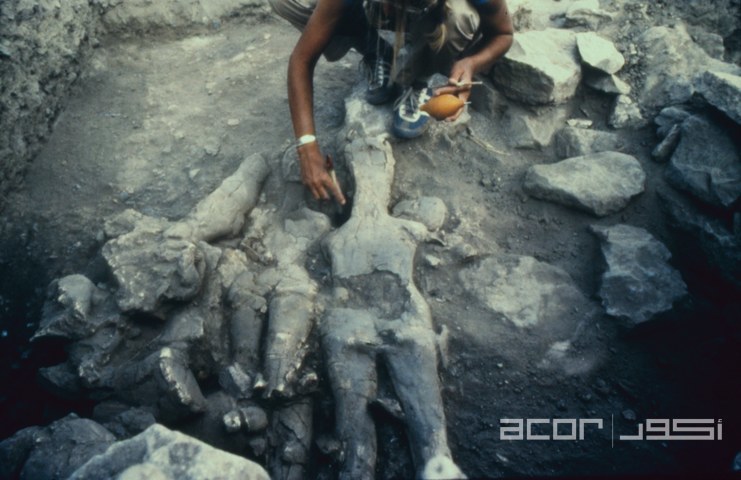‘Ain Ghazal, a site named for a nearby spring (‘ain) and situated along the edge of Wadi Zarqa, was first discovered in 1974 when Jordanian road developers began building Army Street, the freeway connecting Amman and Zarqa. The site’s significance was realized through a series of findings in the early 1980s. ‘Ain Ghazal is of great importance for the study of prehistoric human society. During more than 2,000 years of Neolithic occupation (approximately 7500–5,000 B.C.), the inhabitants of this prehistoric village site cultivated crops, hunted, foraged, and also herded sheep and goats. The site saw changes in domestic architecture, stone-tool technology, use of plaster and clay technology, and animal husbandry. During its peak of occupation, between around 7200 and 6500 B.C., the inhabitants buried several plaster statues beneath the floors of houses, a practice that may in part mirror the sub-floor burial of human remains at the site.
The excavation team uncovered several exquisite ritual artifacts, including clay figurines in the shape of animals and humans, the latter considered to be some of the oldest sculptures of the human form in the Levant. Interpreted as hunting and fertility amulets, these figurines provide insights into daily and ritual life of inhabitants of the Neolithic-era Levant.

ACOR supported the excavations at ‘Ain Ghazal (1982–1998), which were carried out under the direction of Gary O. Rollefson, then of San Diego State University, who received ACOR fellowships for his research on the Neolithic in 1978, 1980, and 1998. He was also the ACOR Annual Professor in 1981–82. Rollefson was joined by co-directors Zeidan Kafafi of the Institute of Archaeology and Anthropology at Yarmouk University and Alan H. Simmons of the University of Nevada at Las Vegas.
The excavations at ‘Ain Ghazal, which ended in 1998, have provided meaningful evidence concerning the social organization and ritual behavior of Neolithic society in the Levant, as well as about developments in occupation resulting from environmental change. Funded by an ACOR-NEH Fellowship in 2017–2018, Rollefson has also shown that areas east of ‘Ain Ghazal, which are now desert, were more lush in Neolithic times, supporting more vegetation, livestock, and human population.

ACOR also aided emergency interventions at ‘Ain Ghazal in 2011–2012, and through its USAID Sustainable Cultural Heritage Through Engagement of Local Communities Project (SCHEP) supported an applied capacity-building program at the site in 2019 in partnership with the Department of Antiquities (DOA). This program responded to an immediate threat to ‘Ain Ghazal posed by impending road works, and was conducted alongside emergency excavations at the site, led by Basem Mahamid of the DOA and supported by SCHEP. Gary Rollefson, who is now at Whitman College in Washington state, had direct involvement in this program, leading workshops for 18 DOA employees, recent graduates, and young researchers.
The applied capacity-building program held at ACOR in December 2019 (see left). Photos courtesy of USAID SCHEP.
For more details, see the following resources, some of which are open access:
Banning, E. B. and Byrd, B. F. 1984. “The Architecture of PPNB ‘Ain Ghazal, Jordan.” Bulletin of the American Schools of Oriental Research 255: 15–20.
Clark, Geoffrey A. 2016. “Jordan in the Context of the Levantine Paleolithic, 1990-2010.” Studies in the History and Archaeology of Jordan 12: 233–50.
Quintero, L. 2010. Evolution of Lithic Economies in the Levantine Neolithic: Development and Demise of Naviform Core Technology as Seen from ‘Ain Ghazal. ‘Ain Ghazal Excavation Reports 2. Berlin: ex oriente.
Rollefson, G. O. 1998. “‘Ain Ghazal (Jordan): Ritual and Ceremony III.” Paléorient 24(1): 43–58.
Rollefson, Gary O. 2015. “ACOR Lecture 20 Oct 2015 by Dr. Gary Rollefson [‘A Kinder, Greener Black Desert in the Late Neolithic 6,500–5,000 B.C.’].” YouTube video, 40:16, 5 December 2015.
Rollefson, Gary O. 2019. “Four Decades of Intensified Neolithic Research in Jordan.” ACOR Newsletter Vol. 31(1): 1–8.
Rollefson, Gary O. and Zeidan Kafafi. 1997. “The 1996 Season at `Ayn Ghazal: Preliminary Report.” Annual of the Department of Antiquities of Jordan 41: 27–48.
Schmandt-Bessarat, D. (ed.). 2013. Symbols at ‘Ain Ghazal. ‘Ain Ghazal Excavation Reports 3. Berlin: ex oriente.
Simmons, Alan H. and Zeidan Kafafi. 1992. “The `Ain Ghazal Survey: Patterns of Settlement in the Greater Wadi as-Zarqa Area, Central Jordan.” Studies in the History and Archaeology of Jordan 4: 77–82.





